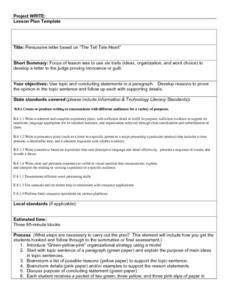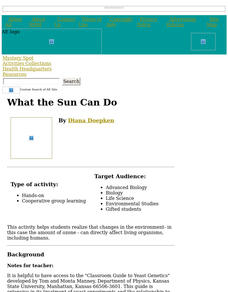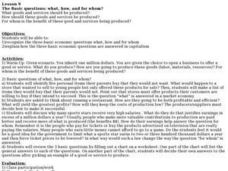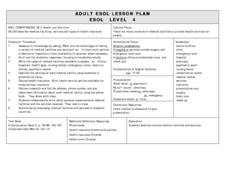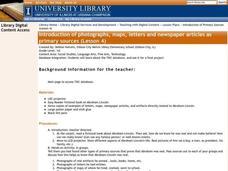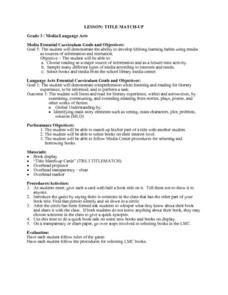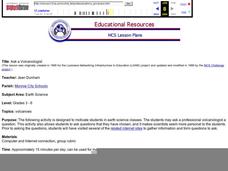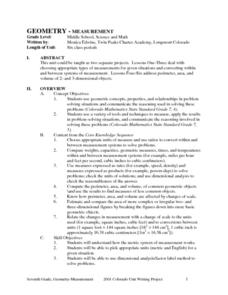Curated OER
Persuasive Letters and The Tell Tale Heart
Students write persuasive letters based on "The Tell Tale Heart." They brainstorm topic sentences, main ideas, and details. They analyze the character and determine if he is innocent or guilty. They create a map listing their reasons to...
Curated OER
Is There A Formula for People?
Young scholars explore proportions which are typical of the human body. Given a list of classic proportions from earlier centuries, students work in pairs to test the validity of the proportions. Pupils share their personal...
Curated OER
Reading Comprehension: 1984
In this reading comprehension worksheet, students answer questions based on chapters 1-12 of '1984'. Question type varies from matching, true / false, fill in the blank and multiple choice.
Curated OER
Language Arts: Creative Writing Devices
Eighth graders review sound and rhythm devices and apply them to their own writing exercises. Next, they interpret the poem, "Where I'm From," as an example of a personal narrative. Using their understanding of poetic devices, they...
Curated OER
Alexander Graham Bell's Patent for the Telephone and Thomas Edison's Patent for the Electric Lamp
Students read a short biographical account about Bell and student B about Edison. Ask each pair to exchange information and determine what qualities these inventors shared. Ask students if they think all inventors share these qualities.
Curated OER
What the Sun Can Do
Learners develop and test a unique, personally-relevant hypothesis about the consequences of exposure to UV radiation based units on a living organism, common baker's yeast (Saccharomyces cerevisiae).
Curated OER
Meat, Poultry, Fish, Eggs: Constructing and Maintaining
Students investigate meat as a source that provides protein, iron and nutrients in the diet. They identify types of meat and their sources, complete a market survey, conduct a fried egg experiment, and prepare various recipes that...
Curated OER
The Basic Questions: What, How, and For Whom?
Students review the various types of economic systems. As a class, they identify the three basic economic questions: what?, How?, and For Whom?. Using capitalism as an economic system, they discuss how each question is answered.
Curated OER
Correlation Chapter 1
Students compare ways in which people form different cultures think about and deal with their physical environment and social conditions. They identify examples of change and recognize examples of cause and effect relationships. Students...
Curated OER
Sundials
Learners investigate the different types of sundials and their history. In this shadows and time of day instructional activity students build their own sundials.
National Science Teachers Association
Adopt-a-Dino
Earth historians research a specific dinosaur, write a paper about the Mesozoic era that it lived in, create an artistic rendition of the environment, and give a presentation in class about what they learned. Be aware that there are...
Curated OER
Lesson Connections
Second graders listen to, analyze, and describe music. They are assessed as to whether they are distinguishing between A and B sections through different types of music. Students imitate echo, motive, phrase and AB or ABA. Finally,...
Curated OER
Magazine Sales Talks
Students role-play to determine the best types of magazines that should be purchased for their media center. They create a sales presentation for a particular magazine in small groups. As they listen to each presentation they evaluate...
Curated OER
Researching Famous People
Student take notes, on a graphic organizer, about the life of a famous person. They create a trading card about their famous person including a portrait and important facts.
Curated OER
Air Quality and Transportation
Second graders study about air pollution and the effects it has on our Earth. Students tally cars on a sheet that has been categorized as follows: One person in car, two persons in car, or three or more persons in car. Students go to...
Curated OER
Communtiy Medical Facilities
Young scholars describe various medical facilities and the services they provide. Working in pairs, students research and list the location and telephone number of community medical facilities and the services they provide. ...
Curated OER
A Safe Place For My Money
Students examine the roles of different types of financial institutions. They also identify the basic accounts found at the institutions. They ask questions to representatives that come and speak to the class.
Curated OER
Introduction of Primary Sources
First graders are introduced to photographs and newspaper articles to be used as primary sources. Using a projecter, they are shown photographs of a famous person to prove they were real and not make believe. In groups, they use...
Curated OER
What Will I Be?
Third gradersl examine personality characteristics that are necessary for careers. They identify characteristics necessary for any type of occupation and discuss gender bias. They write a job description for an occupation of their choosing.
Curated OER
Title Match-Up
Third graders are introduced to a game in which each card they receive will have half of a book title on it. They find the person who has the other half of the title and they sit down in a circle. Students when whisper what they know...
Curated OER
Response to Literature:
Students write about how the book makes them feel, or they can write about what they think the characters are feeling. They share their personal reactions to this very powerful chapter.
Curated OER
September 11, 2001
Third graders discuss one thing that makes them feel special. They read the book "We're Different, We're the Same" and discuss the differences they saw in the people in the book. They discuss how they would treat others who are different...
Curated OER
Ask a Volcanologist
Students ask a professional volcanologist a question online. This lesson allows students to ask questions that they have chosen, and it makes scientists seem more personal to Students.
Curated OER
Geometry - Measurement
Pupils review the procedure for determining appropriate types of measurements for given situations and measurement conversions. They figure perimeter, area, and volume of 2 and 3 dimensional objects.


